 |
Natural History of the
Canary Islands – part 4
by Teresa Farino and John Muddeman
The high mountains and the coast
 Roques de García, Cañadas del Teide, Tenerife© Teresa Farino Roques de García, Cañadas del Teide, Tenerife© Teresa Farino
The High Mountain Zone: Retamar-Codesar
Above 2000 metres, night-time environmental conditions are so harsh that trees cannot grow, such that the Canary Pines are replaced by a unique high-mountain scrub known locally as Retamar-Codesar. Only La Palma and Tenerife reach this altitude in the Canaries, peaking respectively at Roque de los Muchachos (2,426 m) and El Teide (3,715 m), head and shoulders above the rest of the archipelago.
The principal shrubs of these bleak, 'cold desert' habitats are the bushy legumes known as Retama del Teide (Spartocytisus supranubius) and Codeso de Cumbre (Adenocarpus viscosus), both of which are unique to the Canaries. Many of the other shrubs of these heights adopt the classic cushion habit so typical of high-mountain species, in winter resembling nothing so much as a flock of 'vegetable sheep'.
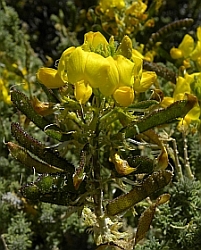 Adenocarpus viscosus© Teresa FarinoAmong the more commonplace species are the crucifers Descurainia bourgeauana and Erysimum scoparium, with yellow and pink flowers, respectively, the figwort Scrophularia glabrata, the scabious Pterocephalus lasiospermus and the composites Argyranthemum tenerifae and Cheirolophus teydis. Adenocarpus viscosus© Teresa FarinoAmong the more commonplace species are the crucifers Descurainia bourgeauana and Erysimum scoparium, with yellow and pink flowers, respectively, the figwort Scrophularia glabrata, the scabious Pterocephalus lasiospermus and the composites Argyranthemum tenerifae and Cheirolophus teydis.
Perhaps the most memorable plant of these heights, however, is the spectacular viper's-bugloss known as Tajinaste Rojo (Echium wildpretii), common in Tenerife's Cañadas del Teide National Park, but extremely rare on La Palma. In late summer, each large, silvery leaf-rosette produces a fat spike several metres tall, studded with hundreds - if not thousands - of small, blood-red flowers.
 Echium wildpretii in the Cañadas del Teide National Park, Tenerife© John Muddeman Echium wildpretii in the Cañadas del Teide National Park, Tenerife© John Muddeman
Less imposing is the delightful little Teide Violet (Viola cheiranthifolia), which holds the record for being the highest naturally-occurring plant of the archipelago, growing among loose screes to a height of some 3,500 m on the summit of Tenerife; the closely related Viola palmensis occupies a similar niche amid the peaks of La Palma's Caldera de Taburiente National Park.
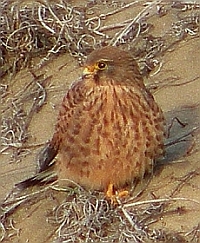 Kestrel Kestrel
Falco tinnunculus canariensis© Teresa Farino
The only birds that breed habitually in the High Mountain Zone are Kestrels (Falco tinnunculus canariensis), Barbary Partridges, Rock Doves (Columba livia canariensis), Plain Swift and Berthelot's Pipits. Possibly of greater interest are the large numbers of endemic invertebrates that can be found only here, notable among which are the Canary Blue butterfly (Cyclirius webbianus), whose caterpillars feed on leguminous shrubs in all vegetation zones of the islands,
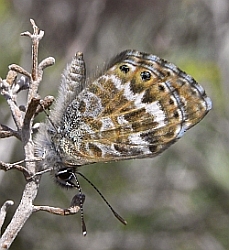 Canary Blue Cyclirius webbianus© Teresa Farinothe grasshopper Sphingonotus willemsei, the longhorn beetle Hesperophanes roridus and the diminutive flightless mantis Pseudoyersinia teydeana, which can sometimes be seen sunning itself on the flowers of Pterocephalus lasiospermus. The Tenerife Lizard (Gallotia galloti) is also very common in the high mountain habitats of both La Palma and Tenerife. Canary Blue Cyclirius webbianus© Teresa Farinothe grasshopper Sphingonotus willemsei, the longhorn beetle Hesperophanes roridus and the diminutive flightless mantis Pseudoyersinia teydeana, which can sometimes be seen sunning itself on the flowers of Pterocephalus lasiospermus. The Tenerife Lizard (Gallotia galloti) is also very common in the high mountain habitats of both La Palma and Tenerife.
Coastal Habitats and Offshore Islets
The shores of the western islands of the archipelago are for the most part rocky and precipitous, whereas in the eastern islands low-lying sandy beaches abound, with sea cliffs present only in western Fuerteventura and northern Lanzarote. The most remote stretches of cliffs are noted for their populations of giant Canary lizards (several distinct species across the archipelago), and frequently possess a rich endemic flora. For example, the Riscos de Famara, in north-western Lanzarote, are home to a unique assemblage of the sea-lavender Limonium bourgaeuii, the pink-flowered, shrubby bindweed Convolvulus lopezsocasi, the fleshy-leaved tree-plantain Plantago famarae and the yellow-flowered composite Reichardia famarae, as well as succulent rosettes of Aichryson tortuosum and Aeonium balsamiferum.
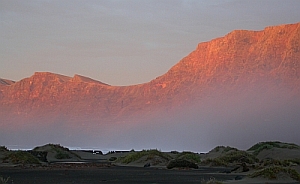 Riscos de Famara, Lanzarote© Teresa Farino Riscos de Famara, Lanzarote© Teresa Farino
Given their oceanic location, it is perhaps not surprising that the coastal cliffs of the Canary Islands - particularly those of undisturbed offshore islets, such as Tenerife's Roques de Anaga and the Archipiélago Chinijo, off northern Lanzarote - harbour important seabird assemblages, including populations of a number of species that do not breed elsewhere in Spain. Birds such as the Macaronesian Shearwater, Bulwer's Petrel (Puffinus bulwerii), both the summer- and winter-breeding populations of Band-rumped, or Madeiran Storm-Petrel (Oceanodroma castro) and the White-faced Storm-Petrel (Pelagodroma marina) are essentially pelagic species that spend most of their lives at sea, coming to land only to nest and rear their young.
The exquisite White-faced Storm-Petrel, which was only discovered as a breeding bird in the Canaries in 1987, is undoubtedly the rarest of these, with a tiny colony of less than 20 pairs known only from the offshore islets of northern Lanzarote.
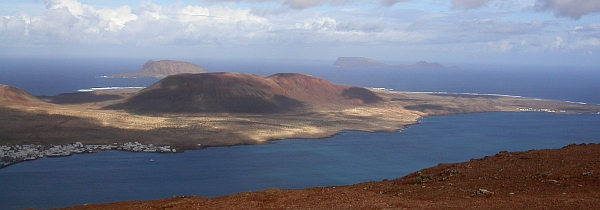 La Graciosa and other islets to the north of Lanzarote© Teresa FarinoThe stunning Red-billed Tropicbird (Phaethon aethereus) is an incipient colonist and has now bred at least twice, and the waters around the islands are also rich feeding grounds for oceanic species at different times of the year, with Wilson's Storm-Petrel (Oceanites oceanicus) and South Polar Skua (Stercorarius maccormicki) occurring regularly in summer and a range of more northerly breeding species in winter. La Graciosa and other islets to the north of Lanzarote© Teresa FarinoThe stunning Red-billed Tropicbird (Phaethon aethereus) is an incipient colonist and has now bred at least twice, and the waters around the islands are also rich feeding grounds for oceanic species at different times of the year, with Wilson's Storm-Petrel (Oceanites oceanicus) and South Polar Skua (Stercorarius maccormicki) occurring regularly in summer and a range of more northerly breeding species in winter.
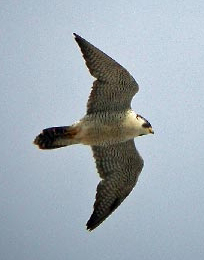 Barbary Falcon Barbary Falcon
Falco pelegrinoides pelegrinoides© John Muddeman
More widespread seabirds that breed in the archipelago include Cory's Shearwater (Calonectris diomedea borealis), the European Storm-Petrel (Hydrobates pelagicus) and Manx Shearwater (Puffinus puffinus), the latter more commonly forming colonies in well-vegetated inland gorges, either nesting on ledges or excavating burrows between the roots of the trees. In addition, three species of raptors typically breed on the coastal cliffs, all of which have suffered enormously from habitat loss and disturbance in recent times. The Osprey (Pandion haliaetus) is almost extinct as a breeding bird in the Canaries today, with fewer than 20 pairs remaining, principally on Lanzarote, La Gomera and El Hierro, although it was once widespread on all the islands, while Eleonora's Falcon (Falco eleonorae) nests only on the islets to the north of Lanzarote today, and the Barbary Falcon is nowhere common, although it probably still breeds on all seven main islands.
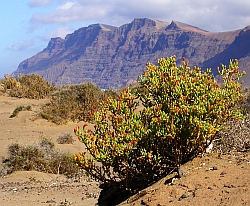 Tetraena fontanesii, Famara, Lanzarote© Teresa Farino Tetraena fontanesii, Famara, Lanzarote© Teresa Farino
Important coastal sand-dune systems occur at Maspalomas on Gran Canaria and Corralejo on Fuerteventura, with less extensive communities of this type occurring on all the main islands. These habitats are populated by an interesting shrubby flora, dominated by the fleshy chenopod Traganum moquinii, the succulent Tetraena fontanesii, distinguished by its almost grape-like leaves, the white-leaved birdsfoot-trefoil Lotus sessilifolius, the sea-lavender Limonium pectinatum and the widespread yellow-flowered composites Schizogyne sericea and Launaea arborescens. On Fuerteventura and Lanzarote, open sands are populated by the charming little Androcymbium psammophilum, a rare, winter-flowering member of the Lily family.
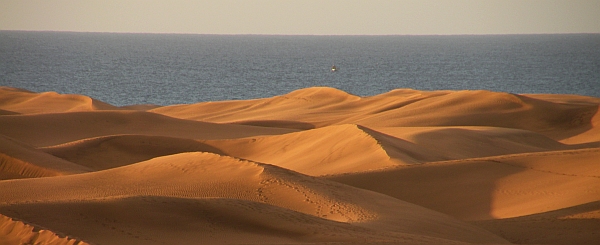 Dunas de Maspalomas, Gran Canaria© Teresa Farino Dunas de Maspalomas, Gran Canaria© Teresa Farino
The most characteristic bird to breed in undisturbed sandy coastal habitats of Lanzarote and Fuerteventura is the Kentish Plover (Charadrius alexandrinus). Although Common Terns (Sterna hirundo) once nested in large colonies in the eastern islands, today the population probably does not exceed 50 pairs, confined mainly to remote coastal habitats in the western islands of La Gomera, La Palma and El Hierro. Even more tragically, the distinctive, all-black Canary Islands Oystercatcher (Haematopus meadewaldoi) - equipped with startlingly red legs and bill - which formerly bred on rocky coasts and sandy shores in the eastern Canary Islands, has not been seen since 1981 and is almost certainly extinct.
|